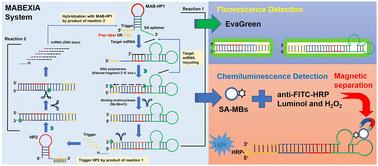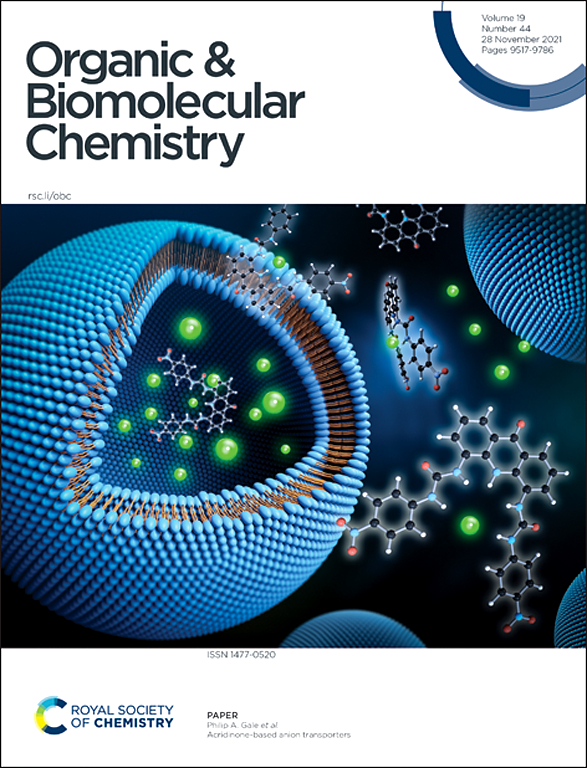Molecular aptamer beacon-based dual-mode exponential isothermal amplification for microRNA detection†
IF 2.7
3区 化学
Q1 CHEMISTRY, ORGANIC
引用次数: 0
Abstract
Due to the limiting factors associated with microRNAs (miRNAs), including their low abundance, short sequence length, and high family sequence homology, the gold standard for miRNA detection does not meet the requirements for rapid and low-cost clinical detection of miRNAs in biological samples. To this end, we developed a one-pot method called molecular aptamer beacon-utilized exponential isothermal amplification (MABEXIA) for analyzing and detecting miRNAs. This novel devolved method was analyzed using both a fluorescent dye and a horseradish peroxidase (HRP) mediated chemiluminescence reaction with luminol and hydrogen peroxide for miRNA detection. The principle of the fluorescence platform involves hybridization of the target miRNA with MAB, which results in the formation of a large amount of double-stranded (ds) DNA products under the dual catalytic action of a DNA polymerase (Klenow Fragment) and nicking endonuclease (Nb.BbvCI) at a constant temperature. Moreover, this method exhibited good detection performance and was successfully applied to 1% human serum for miRNA detection. In contrast to the fluorescence method, the chemiluminescence approach achieved miRNA detection through the targeted interaction between the activated streptavidin (SA) aptamer within the dsDNA product and SA-coated magnetic beads. This method showed a good linear relationship in the ranges of 50 fM to 50 pM for miRNA detection. Finally, this chemiluminescence approach has a detection ability comparable to that of the gold standard for miRNA detection.

基于分子适体信标的双模指数等温扩增检测microRNA。
由于microrna (miRNAs)丰度低、序列长度短、家族序列同源性高等限制因素,目前的检测金标准无法满足临床快速、低成本检测生物样品中miRNA的要求。为此,我们开发了一种称为分子适体信标利用指数等温扩增(MABEXIA)的一锅法来分析和检测mirna。利用荧光染料和辣根过氧化物酶(HRP)介导的化学发光反应对miRNA检测进行了分析。荧光平台的原理是将目标miRNA与MAB杂交,在DNA聚合酶(Klenow Fragment)和切口内切酶(Nb.BbvCI)的双重催化作用下,在恒温下形成大量双链(ds) DNA产物。此外,该方法具有良好的检测性能,并成功应用于1%的人血清中进行miRNA检测。与荧光法相比,化学发光法通过dsDNA产物中活化的链亲和素(SA)适体与SA包被的磁珠之间的靶向相互作用来实现miRNA检测。该方法在50 fM ~ 50 pM范围内对miRNA的检测具有良好的线性关系。最后,这种化学发光方法具有与miRNA检测金标准相当的检测能力。
本文章由计算机程序翻译,如有差异,请以英文原文为准。
求助全文
约1分钟内获得全文
求助全文
来源期刊

Organic & Biomolecular Chemistry
化学-有机化学
CiteScore
5.50
自引率
9.40%
发文量
1056
审稿时长
1.3 months
期刊介绍:
Organic & Biomolecular Chemistry is an international journal using integrated research in chemistry-organic chemistry. Founded in 2003 by the Royal Society of Chemistry, the journal is published in Semimonthly issues and has been indexed by SCIE, a leading international database. The journal focuses on the key research and cutting-edge progress in the field of chemistry-organic chemistry, publishes and reports the research results in this field in a timely manner, and is committed to becoming a window and platform for rapid academic exchanges among peers in this field. The journal's impact factor in 2023 is 2.9, and its CiteScore is 5.5.
 求助内容:
求助内容: 应助结果提醒方式:
应助结果提醒方式:


